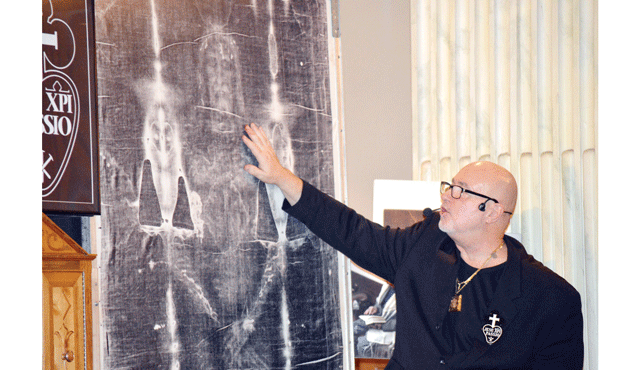For centuries, the images have haunted and enthralled congregants, scientists and scholars alike. The gaunt face of a young man, his head and body bloodied and bruised, the marks of crucifixion plainly evident. The Shroud of Turin, or Holy Shroud, claimed by many to be the burial shroud of the body of Jesus Christ, continues to be a source of debate, of research and scientific revelation.
To some it depicts the face and body of Jesus and is marked by the blood of his passion. To others it’s a medieval hoax. If the latter is true, it’s one of the greatest tricks ever foisted.
Scientists have pored over the frayed 14-foot length of linen for countless hours and conducted hundreds of tests. According to the Shroud of Turin website (www.shroud.com), which has drawn nearly 6 million visitors, the Shroud the most studied artifact in human history. The experts have weighed in, science continues to study the object, theologists have considered the implications and still controversy continues unabated.
“It is the most unique image in the history of the world,” said Fr. Robert Spitzer, a Jesuit priest and founder and president of the nonprofit Magis Center of Reason and Faith on the Christ Cathedral campus.
“It’s an amazing topic,” said Hank Evers, director of marketing for the Diocese of Orange. “It’s the most searched relic on Google. There is so much content, recent content and scientific revelations that are occurring.”
At 7 p.m. on Saturday, October 4 at the Freed Theater, two Shroud of Turin experts, Spitzer and Joseph Morino, will talk about the newest developments in one of the most enduring, puzzling and mysterious artifacts in Christianity.
Spitzer is an author and former president of Gonzaga University, who has written extensively on the intersections of science and faith. Morino is a former Benedictine monk, who has studied the Shroud of Turin since 1977 and is an expert on the controversial carbon dating method used to determine the age of the linen.
Doubters thought scientists had put the issue of the Shroud to bed in 1988, when radiocarbon dating traced the shroud to medieval times, most likely the 13th or 14th century. This finding still holds sway with many in the scientific community and media. Even the Wikipedia page on the Shroud leans toward the idea of a forgery.
It has even been theorized that the Shroud is an ingenious hoax perpetrated by Leonard Da Vinci and that the face on the cloth is his.
However, a paper submitted by Morino in 2000, cast doubt on the carbon dating. According to several studies, scientists somehow overlooked medieval cotton, used by nuns to repair the original linen, into the tested sample.
According to Spitzer, that completely invalidated the test. He added that raw data recently unsealed show severe oversights and procedural missteps or worse in the carbon dating that was done.
“It wouldn’t pass muster with a 101 student in carbon dating,” he said of the sloppiness.
Additionally Spitzer points out that since the carbon dating was conducted, numerous other advanced tests point to the linen dating back to the first century. Tests of hemoglobin and partial DNA evidence also support the theory of Jesus being wrapped in the linen. There is even evidence of pollen unique to Jerusalem in the cloth, he says.
“With the sole exception of the carbon dating,” Spitzer said, “every test points to authenticity.”
Because of the questions and new data, Spitzer said there is great momentum and pressure on the Vatican for a test to verify once and for all the age of the linen.
“I think there will be a time when only the most ardent will argue the (first century) date,” he said.
Of course, answering the date of the Shroud answers only one question. Also open is who the man in the linen is.
Maybe the most puzzling aspect of the Shroud to scientists and potentially revelatory to believers, is how the image was transferred from the body to the linen. According to Spitzer all natural-world hypotheses, painting, dye, scorching, vapor, etc., fail.
That opens the door for a supernatural explanation, such as a glorious resurrection in a flash of brilliance for which science can’t account.
“We’ve got a mystery,” Spitzer said. “The jury is still out.”
The Catholic Church makes no pronouncements on the authenticity of such artifacts. Rather the matter is a personal decision and matter of devotion for the faithful. In the Church’s view, authenticity does not change what Jesus taught or the saving power of his death and resurrection.
“The Vatican wants to say the Gospel is sufficient and that’s it,” Spitzer said. “It’s nice to know that science can have a corroborative and elaborative effect.”
But if the Shroud can be authenticated, he admits it would be wonderful to say, “Holy mackerel, it passed muster.”
Barrie Schwortz, a member of a NASA-led team that studied the Shroud and the creator of the Shroud of Turin website who spoke on the subject at the Diocese in March, once quoted a famous Sir Arthur Conan Doyle line when referring to the Shroud.
“Once you eliminate the impossible, whatever remains, no matter how improbable, must be the truth.”

